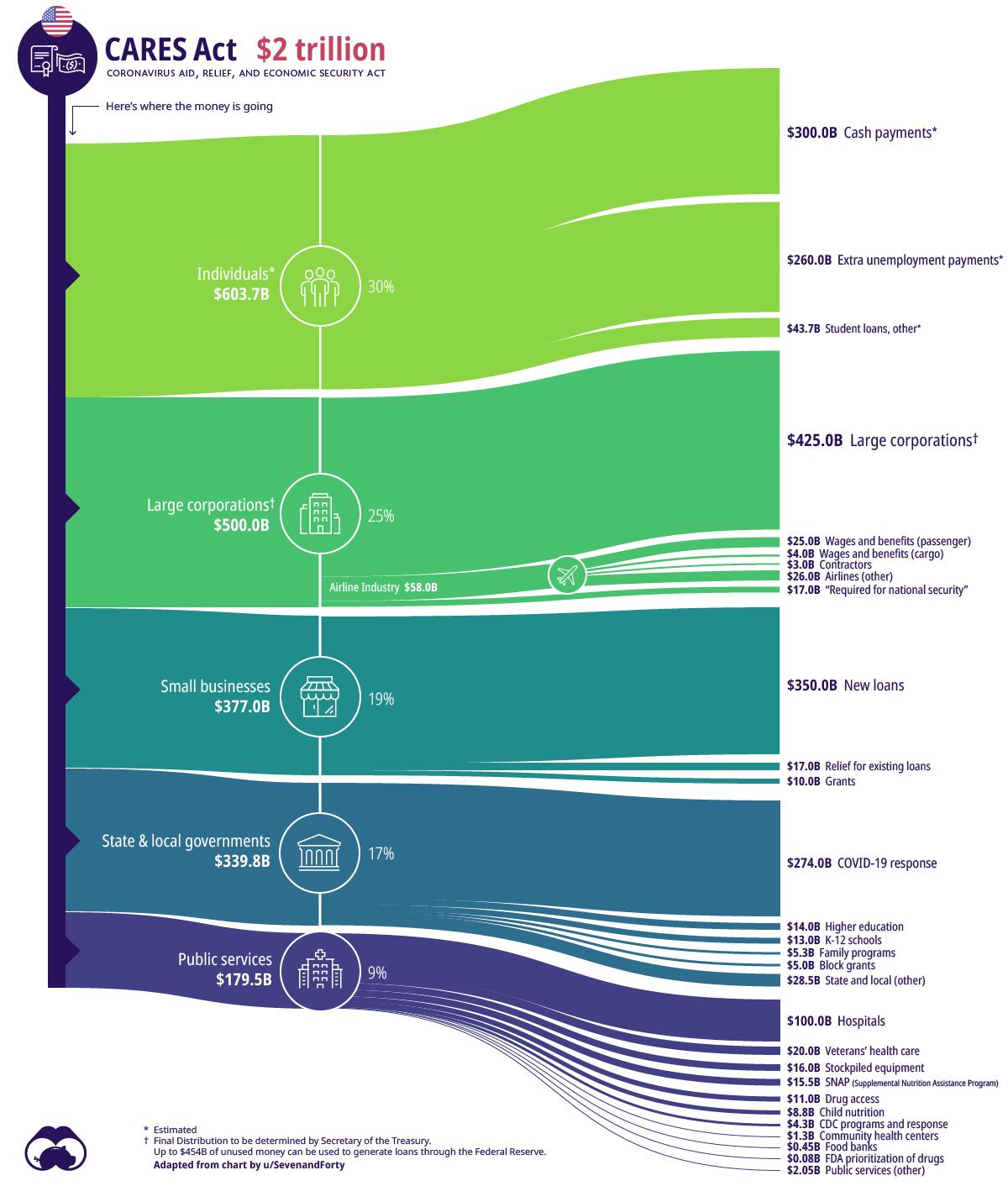Anatomy Of The $2 Trillion COVID-19 Stimulus Bill
Submitted by Visual Capitalist,
The unprecedented response to the COVID-19 pandemic has prioritized keeping people apart to slow the spread of the virus. While measures such as business closures and travel restrictions are effective at fighting a pandemic, they also have a dramatic impact on the economy.
To help right the ship, the Coronavirus Aid, Relief, and Economic Security Act — also known as the CARES Act — was passed by U.S. lawmakers last week with little fanfare. The act became the largest economic stimulus bill in modern history, more than doubling the stimulus act passed in 2009 during the Financial Crisis.
Today’s Sankey diagram is a visual representation of where the $2 trillion will be spent.

Although the COVID-19 stimulus bill is incredibly complex, here are some of the most important parts to be aware of.
Funds for Individuals
Amount: $603.7 billion – 30% of total CARES Act
In order to stimulate the sputtering economy quickly, the U.S. government will deploy “helicopter money” — direct cash payments to individuals and families.
The centerpiece of this plan is a $1,200 direct payment for those earning up to $75,000 per year. For higher earners, payment amounts will phase out, ending altogether at the $99,000 income level. Families will also receive $500 per child.
There are three other key things to know about this portion of the stimulus funds:
- There will be a temporary suspension for any student loan held by the federal government. This means no payments required and no interest accrued until the end of September, 2020.
- Borrowers with federally backed loans can request forbearance on mortgage payments for up to six months.
- There will be an expansion of unemployment benefits, including a four-month enhancement of benefits. This plan includes freelancers, workers in the gig economy, and furloughed employees.
Big Business
Amount: $500.0 billion – 25% of total CARES Act
This component of the package is aimed at stabilizing big businesses in hard-hit sectors.
The most obvious industry to receive support will be the airlines. About $58 billion has been earmarked for commercial and cargo airlines, as well as airline contractors. Perhaps in response to recent criticism of the industry, companies receiving stimulus money will be barred from engaging in stock buybacks for the term of the loan plus one year.
One interesting pathway highlighted by today’s Sankey diagram is the $17 billion allocated to “maintaining national security”. While this provision doesn’t mention any specific company by name, the primary recipient is believed to be Boeing.
The bill also indicates that an inspector general will oversee the recovery process, along with a special committee.
Small Business
Amount: $377.0 billion – 19% of total CARES Act
To ease the strain on businesses around the country, the Small Business Administration (SBA) will be given $350 billion to provide loans of up to $10 million to qualifying organizations. These funds can be used for mission critical activities, such as paying rent or keeping employees on the payroll during COVID-19 closures.
As well, the bill sets aside $10 billion in grants for small businesses that need help covering short-term operating costs.
State and Local Governments
Amount: $340.0 billion – 17% of total CARES Act
The biggest portion of funds going to local and state governments is the $274 billion allocated towards direct COVID-19 response. The rest of the funds in this component will go to schools and child care services.
Public and Health Services
Amount: $179.5 billion – 9% of total CARES Act
The biggest slice of this pie goes to healthcare providers, who will receive $100 billion in grants to help fight COVID-19. This was a major ask from groups representing the healthcare industry, as they look to make up the lost revenue caused by focusing on the outbreak — as opposed to performing elective surgeries and other procedures. There will also be a 20% increase in Medicare payments for treating patients with the virus.
Money is also set aside for initiatives such as increasing the availability of ventilators and masks for the Strategic National Stockpile, as well as providing additional funding for the Center for Disease Control and expanding the reach of virtual doctors.
Finally, beyond the healthcare-related funding, the CARES Act also addresses food security programs and a long list of educational and arts initiatives.
Tyler Durden
Mon, 03/30/2020 – 22:45
via ZeroHedge News https://ift.tt/2xyXjzW Tyler Durden
